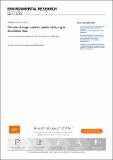| dc.contributor.author | Dadap, Nathan C | |
| dc.contributor.author | Cobb, Alexander R | |
| dc.contributor.author | Hoyt, Alison M | |
| dc.contributor.author | Harvey, Charles F | |
| dc.contributor.author | Feldman, Andrew F | |
| dc.contributor.author | Im, Eun-Soon | |
| dc.contributor.author | Konings, Alexandra G | |
| dc.date.accessioned | 2023-03-14T18:33:39Z | |
| dc.date.available | 2023-03-14T18:33:39Z | |
| dc.date.issued | 2022 | |
| dc.identifier.uri | https://hdl.handle.net/1721.1/148552 | |
| dc.description.abstract | <jats:title>Abstract</jats:title>
<jats:p>When organic peat soils are sufficiently dry, they become flammable. In Southeast Asian peatlands, widespread deforestation and associated drainage create dry conditions that, when coupled with El Niño-driven drought, result in catastrophic fire events that release large amounts of carbon and deadly smoke to the atmosphere. While the effects of anthropogenic degradation on peat moisture and fire risk have been extensively demonstrated, climate change impacts to peat flammability are poorly understood. These impacts are likely to be mediated primarily through changes in soil moisture. Here, we used neural networks (trained on data from the NASA Soil Moisture Active Passive satellite) to model soil moisture as a function of climate, degradation, and location. The neural networks were forced with regional climate model projections for 1985–2005 and 2040–2060 climate under RCP8.5 forcing to predict changes in soil moisture. We find that reduced precipitation and increased evaporative demand will lead to median soil moisture decreases about half as strong as those observed during recent El Niño droughts in 2015 and 2019. Based on previous studies, such reductions may be expected to accelerate peat carbon emissions. Our results also suggest that soil moisture in degraded areas with less tree cover may be more sensitive to climate change than in other land use types, motivating urgent peatland restoration. Climate change may play an important role in future soil moisture regimes and by extension, future peat fire in Southeast Asian peatlands.</jats:p> | en_US |
| dc.language.iso | en | |
| dc.publisher | IOP Publishing | en_US |
| dc.relation.isversionof | 10.1088/1748-9326/AC7969 | en_US |
| dc.rights | Creative Commons Attribution 4.0 International license | en_US |
| dc.rights.uri | https://creativecommons.org/licenses/by/4.0/ | en_US |
| dc.source | IOP Publishing | en_US |
| dc.title | Climate change-induced peatland drying in Southeast Asia | en_US |
| dc.type | Article | en_US |
| dc.identifier.citation | Dadap, Nathan C, Cobb, Alexander R, Hoyt, Alison M, Harvey, Charles F, Feldman, Andrew F et al. 2022. "Climate change-induced peatland drying in Southeast Asia." Environmental Research Letters, 17 (7). | |
| dc.contributor.department | Massachusetts Institute of Technology. Department of Civil and Environmental Engineering | en_US |
| dc.relation.journal | Environmental Research Letters | en_US |
| dc.eprint.version | Final published version | en_US |
| dc.type.uri | http://purl.org/eprint/type/JournalArticle | en_US |
| eprint.status | http://purl.org/eprint/status/PeerReviewed | en_US |
| dc.date.updated | 2023-03-14T18:22:39Z | |
| dspace.orderedauthors | Dadap, NC; Cobb, AR; Hoyt, AM; Harvey, CF; Feldman, AF; Im, E-S; Konings, AG | en_US |
| dspace.date.submission | 2023-03-14T18:22:54Z | |
| mit.journal.volume | 17 | en_US |
| mit.journal.issue | 7 | en_US |
| mit.license | PUBLISHER_CC | |
| mit.metadata.status | Authority Work and Publication Information Needed | en_US |
